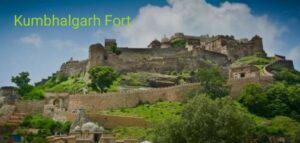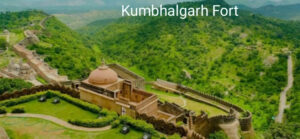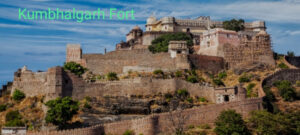Kumbhalgarh Fort, a majestic fortress nestled in the Aravalli Range of Rajasthan, stands as a testament to India’s rich history and architectural brilliance. Recognized as a UNESCO World Heritage Site, this fort is not only a symbol of the valor and grandeur of the Rajputs but also a marvel of medieval engineering.

1. History of Kumbhalgarh Fort
Kumbhalgarh Fort was built in the 15th century by Rana Kumbha, a ruler of the Mewar kingdom, who is credited with the construction of several other important forts in Rajasthan. The fort played a crucial role in the defense strategy of Mewar, serving as a refuge for rulers during times of conflict. Over the centuries, Kumbhalgarh witnessed numerous battles and invasions, withstanding sieges and attacks, including those from the powerful Mughal Empire.
2. Kumbhalgarh Fort: Architecture and Design
The architectural design of Kumbhalgarh Fort is a remarkable blend of Rajput and Mughal styles. The fort encompasses a series of palaces, temples, and residential buildings, all enclosed within a massive wall that stretches over 36 kilometers, making it the second longest continuous wall in the world after the Great Wall of China. The fort’s walls, varying in width and height, are equipped with bastions and watchtowers, demonstrating the strategic and defensive prowess of its builders.

3.Kumbhalgarh Fort: Main Structures within the Fort
1. Kumbha Palace: The primary residence of the Mewar rulers, showcasing intricate carvings and a panoramic view of the surroundings.
2. Badal Mahal: Known as the Palace of Clouds, this structure offers a breathtaking view from its elevated position.
3. Temples: The fort houses numerous temples, the most notable being the Neelkanth Mahadev Temple, dedicated to Lord Shiva.
4. Step Wells and Water Reservoirs: Ingenious water management systems that highlight the fort’s self-sufficiency.
4. Major Attractions
Kumbhalgarh Fort is home to several fascinating attractions that draw visitors from all over the world:
– Kumbha Palace: An architectural gem with royal chambers and scenic vistas.
– Badal Mahal: Renowned for its height and stunning views of the Aravalli hills.
– Temples: Including the revered Neelkanth Mahadev Temple, among many others.
– Step Wells and Water Reservoirs: Essential for understanding the fort’s water conservation techniques.
– Wildlife Sanctuary: Surrounding the fort, it offers a glimpse into the rich biodiversity of the region.

5. Significance in Indian History
Kumbhalgarh Fort’s strategic location and robust defenses made it a pivotal fortress in the Rajputana region. It served as a stronghold against invasions, particularly from the Mughals, and played a crucial role in the region’s resistance against external aggressors. The fort’s history is intertwined with the tales of Rajput bravery, loyalty, and the undying spirit of independence.
6. Visitor Information
For those planning to visit Kumbhalgarh Fort, here are some essential details:
– Best Time to Visit: October to March, when the weather is pleasant.
– How to Reach: The fort is well-connected by road from major cities like Udaipur, which is approximately 85 kilometers away.
– Entry Fees and Visiting Hours: The fort is open daily from morning till evening, with nominal entry fees for both domestic and international tourists.
• Nearby Attractions and Accommodations: Include Ranakpur Jain Temple, Haldighati, and various heritage hotels offering a royal stay experience.
7. Tips for Visitors
– What to Carry: Comfortable walking shoes, water, sunscreen, and a hat.
– Photography Tips: Early morning or late afternoon light provides the best conditions for photography.
– Safety and Preservation Tips: Respect the heritage site by not littering and following the guidelines provided by the authorities.
Conclusion:
Kumbhalgarh Fort is more than just a historic monument; it is a symbol of the rich cultural heritage and architectural ingenuity of India. Visiting this fort offers a glimpse into the valorous past of the Rajputs and the enduring legacy they left behind. As we explore and admire this magnificent fort, it is our responsibility to preserve it for future generations, ensuring that Kumbhalgarh Fort remains a source of pride and inspiration for all.
FAQ:
1.What is Kumbhalgarh Fort famous for?
2.Is 1 day enough for Kumbhalgarh?
3.Is it worth going to Kumbhalgarh Fort?
4.Which is the best season for Kumbhalgarh Fort?
5.Kumbhalgarh fort distance
6.Kumbhalgarh fort wikipedia
7.10 Lines on Kumbhalgarh fort in English
8.Kumbhalgarh Fort timings
9.Kumbhalgarh Fort haunted story
10.Kumbhalgarh Fort Resort

